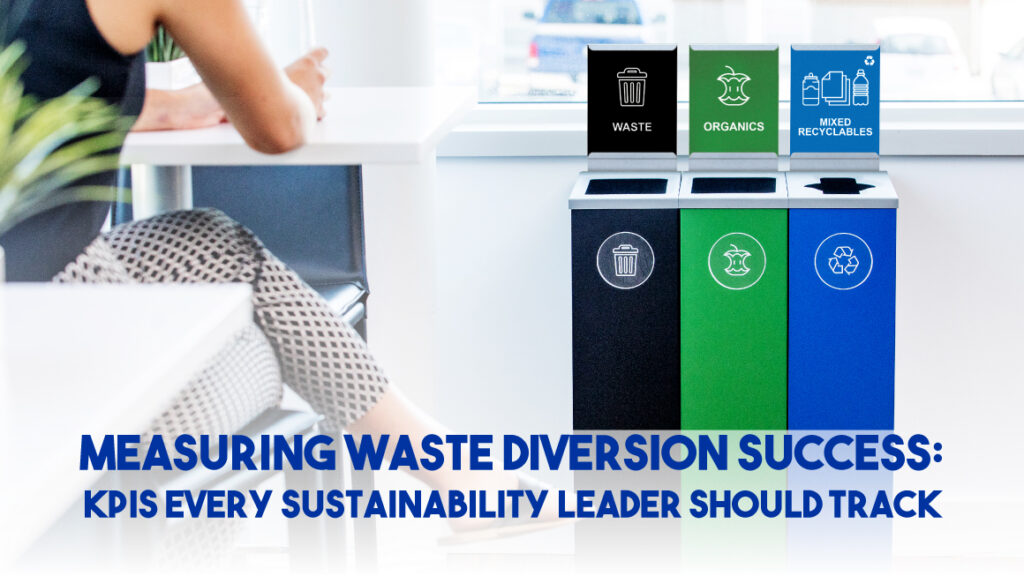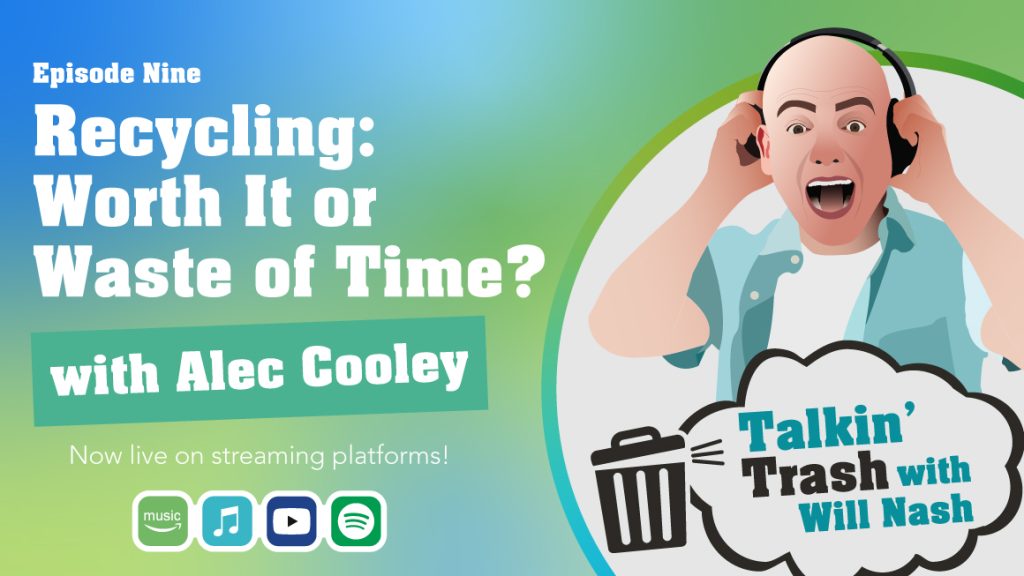So, you’re looking to add to or improve your recycling program? There are some factors you should consider prior to selecting the bins for your needs. Here we have compiled a list of the top 10 things you should look for in recycling bins.
1. The Bin’s Material
When selecting the bin that is right for you, you should first consider the material that the bin is made of. Cost, durability, functionality, features, and customizations can vary depending on bin material.
- Looking for something sturdy? Consider items made primarily out of recycled plastic lumber materials or metal.
- Looking for bins that are more lightweight and maneuverable? Consider plastic molded or PCR items.
There are many options available when it comes to the bin’s material, and finding the right one for your needs is a great place to start.
2. Best Practices for Waste Diversion (Communication)
Indicators for recycling bins are very important when it comes to your recycling program.
- Bin colour: Color-coding bin bodies or lids can help separate streams and encourage correct sorting. Does your region have colour specifications for which items should be disposed of in which bins? If not, research shows that most people associate blue with recycling, green with organics, and black with trash/waste.
- Labels and Signage: Using words and images to communicate what materials are accepted in each stream can help to ensure materials are disposed of correctly.
- Signage: should you have an organics bin, how would you like this represented visually? If you have a bin strictly for cans and bottles, but not for paper, consider avoiding the mobius loop and instead strictly promote cans and bottle disposal for this bin.
- Labels: dictating one bin as for waste, another for paper, etc. are also good indicators.
- Restrictive Openings: having specific shaped openings can help guide correct sorting. Research shows that people associate specific shapes with specific streams (i.e. a circle for cans and bottles collection)
3. Capacity
Understanding the capacity required for your bins is very important. Be sure to select the size of bin that best suits your needs with the following items in mind:
- Foot traffic: knowing how much foot traffic the bin’s placement will see can assist in determining the size of the bin. If foot traffic is higher, consider a larger bin, and the reverse if lower. Waste audits can be a helpful tool in determining volume of waste generated as well.
- Distance: consider how far away bins are from one another to help determine the capacity of your bins. If there is a greater distance, consider a larger bin, or several smaller bins that together manage a high capacity of waste.
- Location: ensure the space of your placement does not create any sort of obstacle and use this to determine the size of your bin. Convenient access encourages proper recycling of materials.
- Servicing Frequency: considering how frequently bins are serviced can help determine capacity needs. Smaller bins may work well for daily servicing, whereas larger bins may be required if servicing is less frequent.
Evaluating these key factors can assist in determining the exact capacity it is that you are after for your program and allow it to be the best recycling program for your space that it can possibly be.
4. Accessibility
Ensuring your bins are accessible is very important for your program. Consider the following:
- Placement: as much as you want to ensure your bin’s placement does not create an obstacle, you must also consider a good spot that ensures the bin is going to receive the maximum use
- Visibility: make sure your bin is easily visible where it is placed and that any party in its area can get to it
- Overall accessibility: if there are children in the bin’s area, are they able to reach the correct openings with ease? Consider any additional needs that may be implemented for proper use and ensure your bin meets any height and size requirements as well
5. Ease of Use and Service
Similar to a combination of capacity and accessibility, you will want to ensure that the bins selected for your program are easy to use and easy to service. Make sure that they are functional within your selected environment when it comes to the user but also be certain that those servicing the bins will not have any trouble. Consider consulting with your team for what option is the easiest for your program; the following can assist in these determinations:
- The lid: for use, are the openings visible and large enough? For collection, would you prefer a lift, removeable, or stationary lid?
- The liners: for use, are they correctly positioned whereas anything that enters the designated opening will find the liner? For collection, do you require handles on the liners? Are they easy to remove and replace the bags?
- The body: do you want your unit to have doors? Are they lockable Do you require casters for easy maneuverability/transport?
6. Design & Aesthetics
When selecting the right type of bin for you, consider the design itself and how it will fit into your space
- Style: Does it fit within your area; does its composition make sense for what items are expected to be disposed of?
- Maintenance: Will it require proper cleaning maintenance? There are many different options available to help best fit your needs.
7. Environmental Benefits & Impacts
Another aspect to consider when selecting the right bins for your program is that of that bin’s environmental benefits & impacts.
- Keep in mind what items are being disposed of in these bins and that you have the proper carry away programs in place as well; ensure organics are being composted correctly, recyclables are being sent to the proper facilities, etc.
- Consider what the bin is made of. Bins made from recycled content help to reduce extraction of natural resources and support a circular economy by giving material a new life.
- Should you be trying to minimize your carbon footprint as best as possible, consider the footprint of the bin itself.
At Busch Systems, we are proud to partner with CarbonGraph to map our product carbon footprints.
8. Product Quality
Be sure that your selection will uphold itself within the environment that you have planned for it. To ensure that your choice of bin will last you a long time, you want the best quality bin to fit your needs. This will also prove to be cost effective and environmentally advantageous over time.
9. Appropriate Program
When selecting your bins, and their overall designs and indicators, be sure that they are set to fit your recycling program specific needs. Consider the following:
- Organics: are these items being collected correctly, preventing any unwanted waste? Are you able to deter any unwanted wildlife/insects from accessing the bin?
- Recyclables: are cans and bottles able to be collected with paper materials or do they need to be separated?
- Hazardous materials: are items such as batteries and lightbulbs collectable options for your area of bin placement?
10. Program Promotion
When selecting the most appropriate bin for you, consider how this can also be used to promote your recycling program. Use the bin as a tool to ensure that the correct recycling protocols are in place and that the bin is being used correctly. Utilizing best practices can motivate and promote a successful recycling program.
Key Takeaways (TL;DR)
- Choose the right material for your recycling bin—durability, cost, and functionality vary (e.g., metal, recycled plastic lumber, molded plastic).
- Use clear communication on your bins—colour-coding, labels, signage, and specially-shaped openings help users sort correctly.
- Match the bin’s capacity to your space: consider foot traffic, servicing frequency, distance between bins, and the location.
- Ensure accessibility: bins should be placed in visible, reachable spots; consider all users including children or those with limited reach.
- Prioritize ease of use & servicing: look at lid design/openings, liner handling, doors/casters—ease for both users and staff.
- Don’t overlook design & aesthetics: the bin should fit into its environment, be maintainable, and look appropriate for its setting.
- Consider the bin’s environmental impact: what it’s made of, whether recycled content is used, and whether it supports your waste-diversion goals.
- Focus on product quality: getting a longer-lasting bin is more cost-effective and better for the environment in the long run.
- Make sure your bin is appropriate for your program: different streams (organics, recyclables, hazardous items) may need different bins or openings.
- Use the bin as a tool for program promotion: the right bin can help promote recycling behaviour, correct sorting, and support your overall recycling program.



